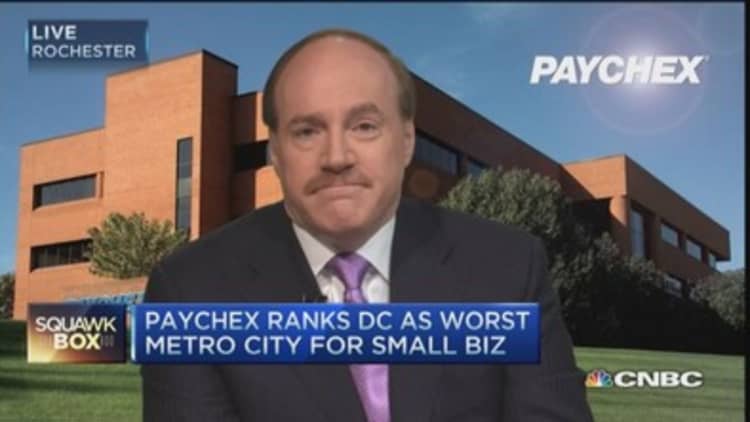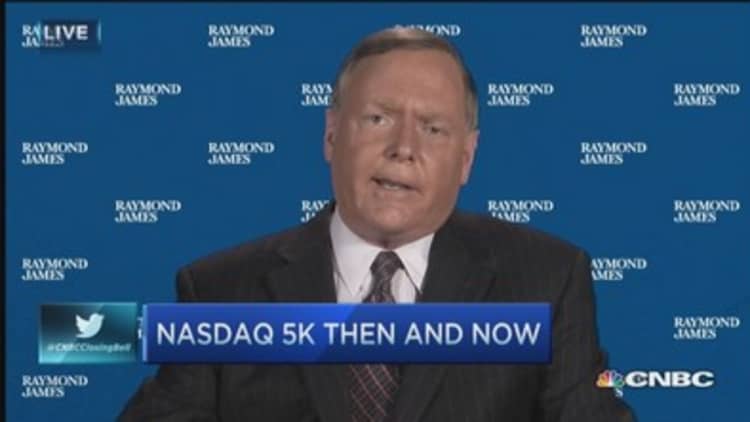


Wednesday's economic reports will be mined for clues on whether the U.S. economy is strong enough for the Fed to become less "patient" this month.
Since Fed Chair Janet Yellen testified to Congress last week, explaining that the removal of the word "patient" from the central bank's statement would be a signal of Fed rate hikes, traders have been looking to game every piece of new economic data.
While it's not clear how long the Fed would wait to raise rates after removing that word, many traders are now focused on the March 18 meeting for the potential language change and June for the first rate hike.

Read MoreLet's not be medieval scholars on Fed: Economist
That makes each piece of data an important measure of whether the economy is clicking along well enough for the Fed to move forward. The big report the markets await this week is Friday's February employment report, but Wednesday's data, including ADP private payrolls, will be a warm up to that report.
ADP is expected to report 215,000 jobs were created when it is released at 8:15 a.m. ET, slightly above the previous reading but well below the 257,000 nonfarm payrolls reported in January.
There is also ISM nonmanufacturing data at 10 a.m. ET, and the Fed's Beige Book on the economy is released at 2 p.m.
"The economy has certainly reached escape velocity. It's not running at 3 percent plus, but the run rate is sufficient to continue to put more Americans back to work and create a lot of job opportunities," said Chris Rupkey, chief financial economist at Bank of Tokyo-Mitsubishi. "The Beige Book will certainly be supportive for dropping the word 'patient' as we get closer and closer to the timing of liftoff here."
Read MoreTarget to cut jobs as part of $2B cost-savings plan
Rupkey said the bond market will be watching to see if the Beige Book shows the economy strengthening and hiring continuing to be strong. "The reasons for delaying liftoff (rate hikes) are falling by the wayside," he said. Treasurys sold off Tuesday, in part because near-record issuance in the corporate debt market weighed on prices. The volume was the second highest ever, boosted by a $21 billion sale by Actavis.
The 10-year Treasury was yielding 2.12 percent late in the day, compared to 2.08 percent Monday.
"The bond market has changed a little bit. The longer the 10-year yield stays above 2 percent, each day it stays up there, you're getting more people talking how those sub-2 percent yields are an anomaly and how yields are going to be adjusting up here," he said. "If the Beige Book was going to be supportive of dropping the word 'patient,' it would be a factor that would accelerate the selloff in bonds."
While bonds sold off Tuesday, stocks also fell as traders reacted to softer-than-expected vehicle sales, among other factors. Stocks had rallied Monday, as money poured in with new March asset allocations. The Nasdaq lost 28 points to 4,979, after crossing above 5,000 for the first time in 15 years Monday. The S&P 500 fell 9 to 2,107.
Car sales were at an annualized selling rate of 16.2 million in February, below the 16.5 million to 16.7 million expected.
February's jobs report is expected to be weaker than January and below the recent three-month trend of 336,000, thanks to huge revisions for November and December.
"I think in general the labor market moderated a little bit in February after some really strong months. I think the weather was a little bit of a dampener and it's time for a breather," said Amherst Pierpont's chief economist, Stephen Stanley. He expects to see 220,000 nonfarm payrolls and a slightly lower unemployment rate at 5.6 percent.
Read MoreBig Money: Are markets ready for June rate hike?
"A lot of this February data is going to have a weather effect. It was bad enough to have some impact. I do think we'll snap back in March or April," he said.
Stanley said he expects the ISM nonmanufacturing survey reading at 56.5, slightly below 56.7 last month.
"I think the tables have turned. ... For some of last year, it was the ISM manufacturing numbers that were puzzlingly strong. The nonmanufacturing were good but not as good as manufacturing. Now things have flipped. The strength in the dollar and the ripple effects of the problems in the ports out west, and to some degree the weather, have begun to hit manufacturing. We've seen the manufacturing numbers come off, but I think nonmanufacturing remains at a sold level," Stanley said.
Traders are also looking ahead to the European Central Bank meeting Thursday.
"I think we're taking our cues from a pretty poor close in Europe. The European bank index was down 1.5 percent. European markets were up big going into details on QE, and I think those names took a breather," said Peter Boockvar, chief market analyst with The Lindsey Group.
Some traders say the bond market could become more volatile once the ECB starts its quantitative easing bond-buying program, particularly if it drives rates higher as it did in the U.S. Treasury yields had followed Europe lower on the promise of QE, before moving higher in recent sessions.
Besides data, earnings reports are expected Wednesday morning from Brown Forman, Abercrombie & Fitch and Trina Solar.
After the bell, reports are expected from H&R Block, PetSmart, Embraer, Momo, Semtech and Vivint Solar.
Traders are also watching for oil and gasoline inventory data at 10:30 a.m. Wednesday. Oil rose Tuesday as violence escalated in Libya and on concerns about the Iran nuclear program, with Israeli Prime Minister Benjamin Netanyahuwarning about the dangers of an Iranian nuclear deal before Congress.
WTI crude futures rose 1.9 percent to $50.52 a barrel, and Brent crude rose 2.5 percent to end at $61.02 per barrel.


